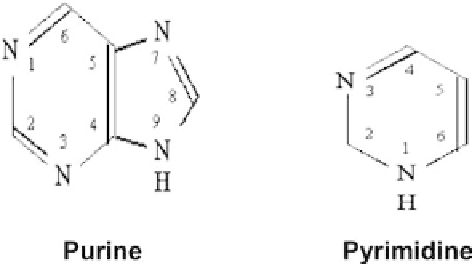Biology Reference
In-Depth Information
16.2 Nucleic Acids
Nucleotides consist of a nitrogenous base, a pentose group, and a
phosphate molecule. A molecule that does not contain a phosphate
molecule is named as nucleoside. The nitrogenous bases are
derivatives ofpyrimidine and purine (Fig. 16.1).
Nitrogenous base molecules are weak basic compounds, thus
called bases. The base is covalently bound to the 1
Cofpentosein
an N-
-glycosyl bond via removal of water and the phosphate is
esterified to 5
C. The purine derivative bases are adenosine (A) and
guanine (G), the pyrimidine derivatives are cytosine (C), thymine
(T), andurasil (U) (Fig. 16.2).
Nucleic acids have two kinds of pentoses: 2
-deoxy-D-ribose
and D-ribose. Both of them are present in their furanose form
in nucleic acids (Fig. 16.3). These sugar residues can easily
bend and twist into different conformations thus making nucleic
acids dynamic in structure. Depending on the kind of pentose,
nucleotidesaresubclassifiedintodeoxyribonucleotidesandribonu-
cleotides (Fig. 16.4). Ribonucleotides might contain A, G, C, and U
while deoxyribonucleotides contain A, G, C, and T. The bases of DNA
and RNA are important for the structure and e
−
distribution of
nucleic acids.
The successive nucleotides in deoxyribonucleic acid (DNA) and
ribonucleic acid (RNA) are covalently linked via phosphodiester
bond. In this binding, the 5'OH group of one nucleotide is bridged
to the 3'OHof the nextnucleotide (Fig. 16.5).
β
Figure 16.1.
Structures of pyrimidine and purine.









